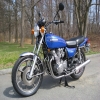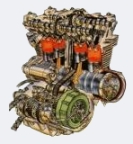Tank liner choice
- katit
-
Topic Author
- Offline
- User
-

Registered
- Posts: 460
- Thanks: 47
Tank liner choice
18 Feb 2021 09:52
Hi! I may not even need tank liner but I really don't want to learn about it after painting.
I though installing it is a way to go (and cheap insurance). But reading another topic - I don't want to "uninstall it"
My question is:
1. Do you agree it's a cheap insurance or I should test for leaks first and do it only if it leaks? Hard to tell, leaks might appear after I sand through bubbles (not that many) and paint?
2. If doing it: Caswell or POR15?
I though installing it is a way to go (and cheap insurance). But reading another topic - I don't want to "uninstall it"
My question is:
1. Do you agree it's a cheap insurance or I should test for leaks first and do it only if it leaks? Hard to tell, leaks might appear after I sand through bubbles (not that many) and paint?
2. If doing it: Caswell or POR15?
78 KZ650B2A - resto in progress
www.kzrider.com/forum/11-projects/615161...s-1978-kz650-project
Other bikes: 1978 BMW R100/7, 1978 Moto Guzzi T3, 2016 DRZ400s
www.kzrider.com/forum/11-projects/615161...s-1978-kz650-project
Other bikes: 1978 BMW R100/7, 1978 Moto Guzzi T3, 2016 DRZ400s
Please Log in or Create an account to join the conversation.
- Nessism
-
- Away
- Sustaining Member
-

Registered
- Posts: 7989
- Thanks: 3361
Re: Tank liner choice
18 Feb 2021 10:44
There are many different point of view on the topic of tank cleaning and sealing.
I like to use phosphoric acid to derust (the same thing that Por-15 specifies.) It does a good job, is fast, doesn't need to be neutralized other than rinsing, and is pretty safe. As a bonus it's cheap, readily available, and it leaves the metal with a protective film that helps ward off (but not eliminate) flash rust when rinsing.
There are other good derusters like evaporust and the like. These are actually top of the heap in my opinion, but they are more expensive and slower.
Vinegar also works but it much slower. It's cheap and easy to dispose of so those are two good bonuses.
Using something strong like HCl works but is more risky. It needs to be neutralized and disposed of carefully. You can expect rapid flash rusting after rinsing too.
If the metal is solid and strong, with minimal thinning, and you are able to get the tank 100% free of rust I'd stop right there and call it done. If the metal is thinned and or springs a leak then I'd go the liner route.
Por-15 is thin like a thick paint and is easy to work with. This would be my first choice unless there is significant metal erosion. In that instance I'd go for Caswell's tank sealer. It's super thick and flows like cold honey. I recommend thinning it to the max allowable on the label. Because it's so thick though it helps reinforce thin metal, include sealing leaks. Tape over the leak area on the outside of the tank before sealing.
When sealing it's critical to flow the material all over the tank to get every inch of the surface covered. Then I'd go over it a second and third time. Then dump out the excess. There will still be extra material in the tank so keep turning it until the material kicks off and stops flowing. Only then can you rest and put the tank down.
It's a lot of work but done right a sealed tank will last for years.
I like to use phosphoric acid to derust (the same thing that Por-15 specifies.) It does a good job, is fast, doesn't need to be neutralized other than rinsing, and is pretty safe. As a bonus it's cheap, readily available, and it leaves the metal with a protective film that helps ward off (but not eliminate) flash rust when rinsing.
There are other good derusters like evaporust and the like. These are actually top of the heap in my opinion, but they are more expensive and slower.
Vinegar also works but it much slower. It's cheap and easy to dispose of so those are two good bonuses.
Using something strong like HCl works but is more risky. It needs to be neutralized and disposed of carefully. You can expect rapid flash rusting after rinsing too.
If the metal is solid and strong, with minimal thinning, and you are able to get the tank 100% free of rust I'd stop right there and call it done. If the metal is thinned and or springs a leak then I'd go the liner route.
Por-15 is thin like a thick paint and is easy to work with. This would be my first choice unless there is significant metal erosion. In that instance I'd go for Caswell's tank sealer. It's super thick and flows like cold honey. I recommend thinning it to the max allowable on the label. Because it's so thick though it helps reinforce thin metal, include sealing leaks. Tape over the leak area on the outside of the tank before sealing.
When sealing it's critical to flow the material all over the tank to get every inch of the surface covered. Then I'd go over it a second and third time. Then dump out the excess. There will still be extra material in the tank so keep turning it until the material kicks off and stops flowing. Only then can you rest and put the tank down.
It's a lot of work but done right a sealed tank will last for years.
Ed
Carb O-ring Kits : www.kzrider.com/forum/14-vendor-forum/62...rburetor-o-ring-kits
www.kzrider.com/forum/faq-wiki/618026-new-owner-things-to-know
1981 KZ750E2
www.kzrider.com/forum/11-projects/604901...z750e-project-thread
Carb O-ring Kits : www.kzrider.com/forum/14-vendor-forum/62...rburetor-o-ring-kits
www.kzrider.com/forum/faq-wiki/618026-new-owner-things-to-know
1981 KZ750E2
www.kzrider.com/forum/11-projects/604901...z750e-project-thread
The following user(s) said Thank You: katit
Please Log in or Create an account to join the conversation.
- ckahleer
-
- Offline
- User
-

Registered
- Posts: 514
- Thanks: 177
Re: Tank liner choice
18 Feb 2021 14:25
[quote="Nessism"
If the metal is solid and strong, with minimal thinning, and you are able to get the tank 100% free of rust I'd stop right there and call it done
+1 on Nessism's advice. I picked up an 85 V65 Magna 9 years ago. The inside of the tank was slightly rusted, so I cleaned the rust out and did nothing more.
I still have that bike, and the rust has not returned. It is kept in a garage that never goes below freezing. Maybe with a bike left outdoors this would not be the case.
If the metal is solid and strong, with minimal thinning, and you are able to get the tank 100% free of rust I'd stop right there and call it done
+1 on Nessism's advice. I picked up an 85 V65 Magna 9 years ago. The inside of the tank was slightly rusted, so I cleaned the rust out and did nothing more.
I still have that bike, and the rust has not returned. It is kept in a garage that never goes below freezing. Maybe with a bike left outdoors this would not be the case.
1997 ZL600
94 KE100
82 KZ305
74 TC185
94 KE100
82 KZ305
74 TC185
Please Log in or Create an account to join the conversation.
- Mr. E
-

- Offline
- User
-

Registered
- Posts: 106
- Thanks: 32
Re: Tank liner choice
19 Feb 2021 09:31 - 19 Feb 2021 09:32
I have POR15 in my wifes KZ400 and time will tell on that liner, However, I have an SR650 tank with a failed caswell liner. Should be a fun process to remove.
Based these two I would go with the POR15 if a liner is needed.
Based these two I would go with the POR15 if a liner is needed.
1977 kz1000 - the Rooster, 1981 KZ750 Chopper, 1975 KZ400 , 1984 GPZ750
Last edit: 19 Feb 2021 09:32 by Mr. E.
Please Log in or Create an account to join the conversation.
- Kidkawie
-

- Offline
- User
-

Registered
- I bleed premix
- Posts: 1913
- Thanks: 243
The following user(s) said Thank You: 650ed
Please Log in or Create an account to join the conversation.
- 650ed
-

- Offline
- User
-

Registered
- Posts: 15337
- Thanks: 2833
Re: Tank liner choice
20 Feb 2021 05:54
Kidkawie is correct - none is best. Ed
1977 KZ650-C1 Original Owner - Stock (with additional invisible FIAMM horn)
Please Log in or Create an account to join the conversation.
- z1kzonly
-

- Offline
- User
-

Registered
- Sustaining Member
- Posts: 2820
- Thanks: 528
Re: Tank liner choice
20 Feb 2021 07:01TheWhiteDevil wrote: I have an SR650 tank with a failed Caswell liner. Should be a fun process to remove.
Based these two I would go with the POR15 if a liner is needed.
Hey White Chopper Devil? Can you tell me about the bad Caswell experience? I put it in a set of 1970 OEM Harley fat bob tanks.
I did not paint them yet. I coated them last year! :laugh: All my projects take time! I never finish because I start another one and work on 10 projects at the same time
I did prep it well, even though Caswell says to leave some bad? For their product to stick. I did it all! acid, black cat aggressive media blast in the blast cabinet, dry wall screws with a lacquer thinner wash. Did it in summer, baked in the sun! I loved the stuff. But nothing has been in it yet.
Thanks.
Livin in "CheektaVegas, NY
Went thru 25 of these in 40 yrs.
I SOLD OUT! THE KAW BARN IS EMPTY.
More room for The Old Girl, Harley 75 FLH Electra Glide,
Old faithful! Points ign. Bendix Orig. carb.
Starts everytime!
Went thru 25 of these in 40 yrs.
I SOLD OUT! THE KAW BARN IS EMPTY.
More room for The Old Girl, Harley 75 FLH Electra Glide,
Old faithful! Points ign. Bendix Orig. carb.
Starts everytime!
Please Log in or Create an account to join the conversation.
- Nessism
-
- Away
- Sustaining Member
-

Registered
- Posts: 7989
- Thanks: 3361
Re: Tank liner choice
20 Feb 2021 07:48z1kzonly wrote: I did prep it well, even though Caswell says to leave some bad? For their product to stick.
I call BS on Caswell for that. Por-15 suggests the same but don't believe it. Remove ALL the rust before sealing. And the only reason to seal is if the metal thins out and/or you spring leaks while derusting.
Ed
Carb O-ring Kits : www.kzrider.com/forum/14-vendor-forum/62...rburetor-o-ring-kits
www.kzrider.com/forum/faq-wiki/618026-new-owner-things-to-know
1981 KZ750E2
www.kzrider.com/forum/11-projects/604901...z750e-project-thread
Carb O-ring Kits : www.kzrider.com/forum/14-vendor-forum/62...rburetor-o-ring-kits
www.kzrider.com/forum/faq-wiki/618026-new-owner-things-to-know
1981 KZ750E2
www.kzrider.com/forum/11-projects/604901...z750e-project-thread
Please Log in or Create an account to join the conversation.
- ThatGPzGuy
-

- Offline
- Sustaining Member
-

Registered
- More Sparky than Speed Racer
- Posts: 1515
- Thanks: 398
Re: Tank liner choice
20 Feb 2021 10:48
Caswell is my weapon of choice. I have never heard of a Caswell failure before this. Hell, I spilled some on my garage floor and it is going to have to be chiseled off.
Jim
North GA
2016 Yamaha FJR1300ES
1982 GPz750 R1
1974 Kawasaki H1
1976 Kawasaki KZ400
1979 Yamaha XS650 cafe'
2001 KZ1000P (sold)
2001 Yamaha YZ426
1981 Honda XR200 stroked in an '89 CR125 chassis
1965 Mustang
1967 Triumph GT6
1976 Bronco
"If you didn't build it, it's not really yours"
North GA
2016 Yamaha FJR1300ES
1982 GPz750 R1
1974 Kawasaki H1
1976 Kawasaki KZ400
1979 Yamaha XS650 cafe'
2001 KZ1000P (sold)
2001 Yamaha YZ426
1981 Honda XR200 stroked in an '89 CR125 chassis
1965 Mustang
1967 Triumph GT6
1976 Bronco
"If you didn't build it, it's not really yours"
Please Log in or Create an account to join the conversation.
- ckahleer
-
- Offline
- User
-

Registered
- Posts: 514
- Thanks: 177
Re: Tank liner choice
20 Feb 2021 11:56
+1 on Caswell. I used it several years ago on my XT225 that had pinhole leaks in several spots. Its more than a coating, its a 2 part epoxy. I believe with a second application, I could peel the metal away and have an epoxy tank.
1997 ZL600
94 KE100
82 KZ305
74 TC185
94 KE100
82 KZ305
74 TC185
The following user(s) said Thank You: Nessism
Please Log in or Create an account to join the conversation.
- cb900f
-

- Offline
- User
-

Registered
- Posts: 111
- Thanks: 30
Re: Tank liner choice
20 Feb 2021 12:17Nessism wrote: I like to use phosphoric acid to derust (the same thing that Por-15 specifies.) It does a good job, is fast, doesn't need to be neutralized other than rinsing, and is pretty safe. As a bonus it's cheap, readily available, and it leaves the metal with a protective film that helps ward off (but not eliminate) flash rust when rinsing.
And, it's reusable - at least to the point where is doesn't do anything anymore.
The following user(s) said Thank You: Nessism
Please Log in or Create an account to join the conversation.
- Nessism
-
- Away
- Sustaining Member
-

Registered
- Posts: 7989
- Thanks: 3361
Re: Tank liner choice
20 Feb 2021 14:33cb900f wrote:Nessism wrote: I like to use phosphoric acid to derust (the same thing that Por-15 specifies.) It does a good job, is fast, doesn't need to be neutralized other than rinsing, and is pretty safe. As a bonus it's cheap, readily available, and it leaves the metal with a protective film that helps ward off (but not eliminate) flash rust when rinsing.
And, it's reusable - at least to the point where is doesn't do anything anymore.
(in the USA at Home Depot) Kleen Strip Etch and Prep is phosphoric acid. I've got a gallon ($15) that's been used dozens of times and it's still potent. Sludge develops on the bottom of the jug so I short pour when using it. It started out green and now it's clearish, but it still works great. Amazing stuff. Recycle again and again.
Ed
Carb O-ring Kits : www.kzrider.com/forum/14-vendor-forum/62...rburetor-o-ring-kits
www.kzrider.com/forum/faq-wiki/618026-new-owner-things-to-know
1981 KZ750E2
www.kzrider.com/forum/11-projects/604901...z750e-project-thread
Carb O-ring Kits : www.kzrider.com/forum/14-vendor-forum/62...rburetor-o-ring-kits
www.kzrider.com/forum/faq-wiki/618026-new-owner-things-to-know
1981 KZ750E2
www.kzrider.com/forum/11-projects/604901...z750e-project-thread
Please Log in or Create an account to join the conversation.
Moderators: Street Fighter LTD
